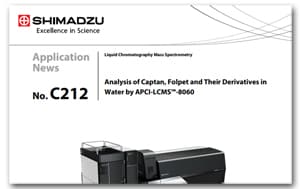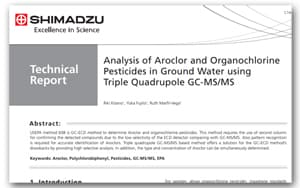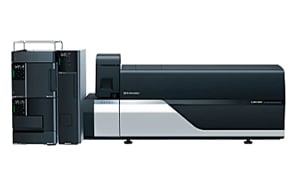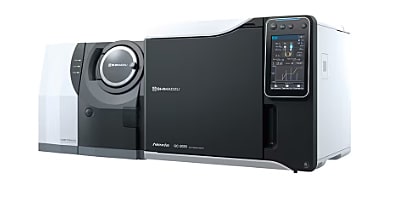The LCMS-8060 features an optimized ion guide and new technologies incorporated in the ion transport optical system. As a result, the ion sampling efficiency and ion focusing capability are significantly increased, to achieve improved sensitivity, approx. 3 times better than that of the LCMS-8050.
POPs and Pesticides-Environmental water

Water in the environment contains a variety of elements, including those related to industrial and agricultural activity and urban waste. Pesticides and persistent organic pollutants (POPs) are strictly regulated worldwide because they are compounds that tend to remain in the environment for a long time and can be harmful to humans. Accurate quantification of these substances is required even at low concentrations. This necessary microanalysis can be done through LC/MS/MS or GC/MS/MS.
Application News
LC-MS
Analysis of Captan, Folpet and Their Derivatives in Water by APCI-LCMS™-8060 - Liquid Chromatograph-Mass Spectrometry
Captan and folpet are phytosanitary products belonging to the phthalimide family and are widely used as fungicides. These compounds and their derivatives phthalimide and tetrahydrophthalimide are ecotoxic, in particular for aquatic organisms. Therefore, the aim of this study was the development of a quantification method for drinking and surface water. Taking advantage of the performance of the Shimadzu LCMS-8060 system with an APCI interface, a fast, sensitive method was developed, enabling analysis from a raw water sample without preparation by direct injection in a 6 min method.
GC-MS
Analysis of Aroclor and Organochlorine Pesticides in Ground Water using Triple Quadrupole GC-MS/MS
USEPA method 608 is GC-ECD method to determine Aroclor and organochlorine pesticides. This method equires the use of second column for confirming the detected compounds due to the low selectivity of the ECD detector comparing with GC-MS/MS. Also pattern recognition is required for accurate identification of Aroclors. Triple quadrupole GC-MS/MS based method offers a solution for the GC-ECD method’s drawbacks by providing high selective analysis. In addition, the type and concentration of Aroclor can be simultaneously determined.
Analysis of PCBs and Organochlorinated Pesticides in River Water Using Simultaneous Scan/MRM Measurement in GC-MS/MS (1)
PCBs and some chlorinated pesticides are resistant to decomposition in the environment, and tend to accumulate in living organisms. As a result, they are designated as POPs (Persistent Organic Pollutants) under the Stockholm Convention. In monitoring these environmental pollutants in river water and sludge, sensitivity for the detection of trace quantities and separation from impurities in the samples become important issues. In addition, in recent years, incidents of the discharge of chemical substances have increased on a global scale, heightening demands for the identification of unanticipated pollutants in order to investigate causes and take necessary measures swiftly.
This article introduces the results of simultaneous scan/MRM measurements with respect to PCBs and chlorinated pesticides.
Related Products
-
-
The Shimadzu triple-quad GCMS-TQ8040 NX features smart technologies to boost the efficiency of routine analytical work. For example, Smart MRM provides fully-automated MRM method development. It automatically determines all optimum transitions and collision energies, seamlessly incorporating them into the Smart Database Series. With features like this, the GCMS-TQ8040 NX GC-MS/MS is so smart it almost runs itself! Perfect for applications in fields such as environmental monitoring and food science.







